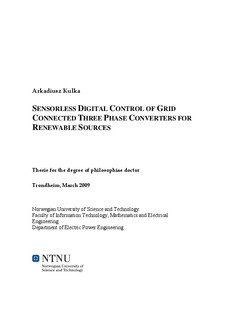| dc.contributor.advisor | Undeland, Tore | nb_NO |
| dc.contributor.author | Kulka, Arkadiusz | nb_NO |
| dc.date.accessioned | 2014-12-19T13:50:44Z | |
| dc.date.available | 2014-12-19T13:50:44Z | |
| dc.date.created | 2009-06-12 | nb_NO |
| dc.date.issued | 2008 | nb_NO |
| dc.identifier | 223451 | nb_NO |
| dc.identifier.isbn | 978-82-471-1636-4 | nb_NO |
| dc.identifier.uri | http://hdl.handle.net/11250/256425 | |
| dc.description.abstract | Power electronic converters have become popular in the field of power transformation for renewable energy. Power electronics converters achieve high efficiency, and the price of their components is falling, thus making them even more beneficial for renewable energy applications. Those systems coupled to the grid need to withstand certain utility-defined circumstances which may occur during operation. Additionally the new net regulations for large generation plants specify that during specified severe grid disturbances the relatively delicate converters should stay connected supporting the system. For PV inverters the forthcoming standards may optionally add the possibility of reactive power compensation where for wind-power those standards are already in use.
This thesis focuses on reliable, sensor-less control of the PWM converters coping with varying grid conditions and existing problems. The thesis presents a variety of digital control solutions for interfacing PWM converter with the grid, synchronization, sensorless operation and grid impedance detection.
The introductory chapter gives the fundamental theory about three-phase converters and control.The following chapters deal with unbalanced condition and symmetric component decomposition, which is the tool to cope with unbalanced grid voltages or currents.
A sensor-less operation method using dual frame virtual flux model is presented with good results. In addition sensor-less synchronization to the grid is shown. Moreover an algorithm based on virtual flux for grid inductance estimation is also successfully demonstrated. Knowing the grid inductance is important during weak grid operation, since it is needed in order to provide unity power factor to the point of common connection.
At the end of the thesis, a control algorithm for voltage harmonic compensation during stand alone operation is presented. The presented algorithm gives the possibility to supply high quality power in isolated islands, where the load is unknown. Furthermore, this algorithm can be successfully used for UPS applications. The last chapter applies the voltage harmonic control to the Z-source converter having the possibility of achieving higher ac voltage than in conventional VSI, results are promising. | nb_NO |
| dc.language | eng | nb_NO |
| dc.relation.ispartofseries | Doktoravhandlinger ved NTNU, 1503-8181; 2009:125 | nb_NO |
| dc.subject | power converter | en_GB |
| dc.subject | renewable energy | en_GB |
| dc.subject | wind power | en_GB |
| dc.subject | solar power | en_GB |
| dc.subject | dsp control | en_GB |
| dc.subject | digital control | en_GB |
| dc.title | Sensorless Digital Control of Grid Connected Three Phase Converters for Renewable Sources | nb_NO |
| dc.type | Doctoral thesis | nb_NO |
| dc.source.pagenumber | 147 | nb_NO |
| dc.contributor.department | Norges teknisk-naturvitenskapelige universitet, Fakultet for informasjonsteknologi, matematikk og elektroteknikk, Institutt for elkraftteknikk | nb_NO |
| dc.description.degree | PhD i elektronteknikk | nb_NO |
| dc.description.degree | PhD in Electrical Engineering | en_GB |
